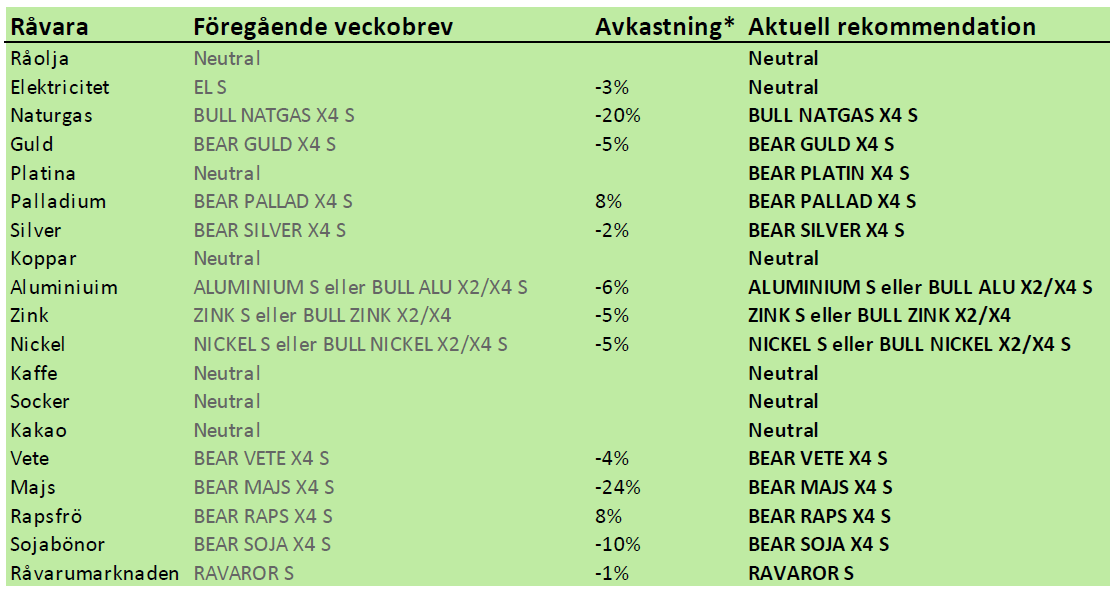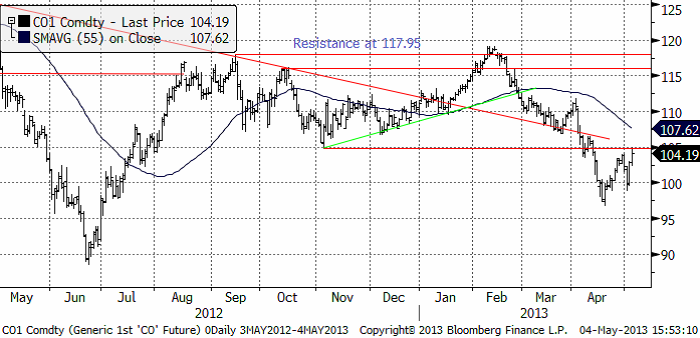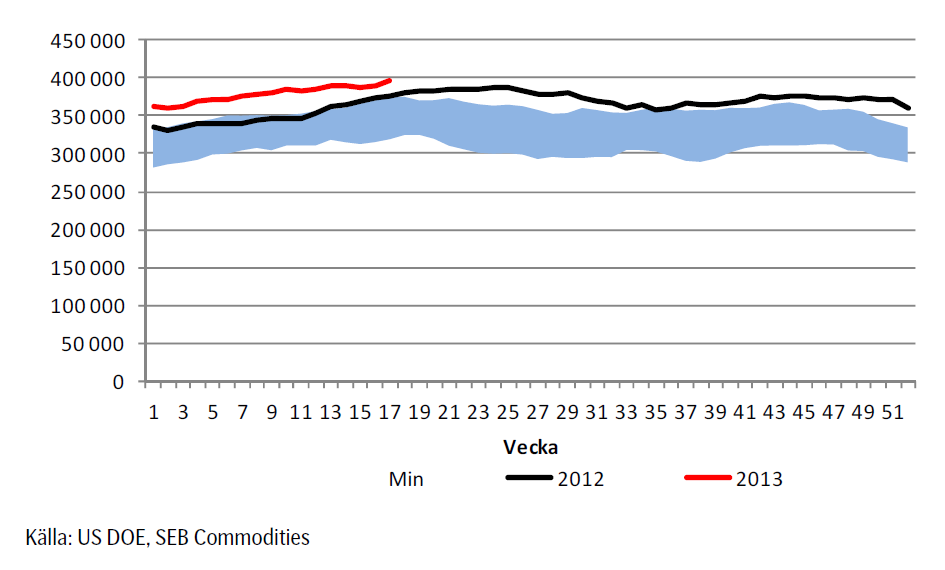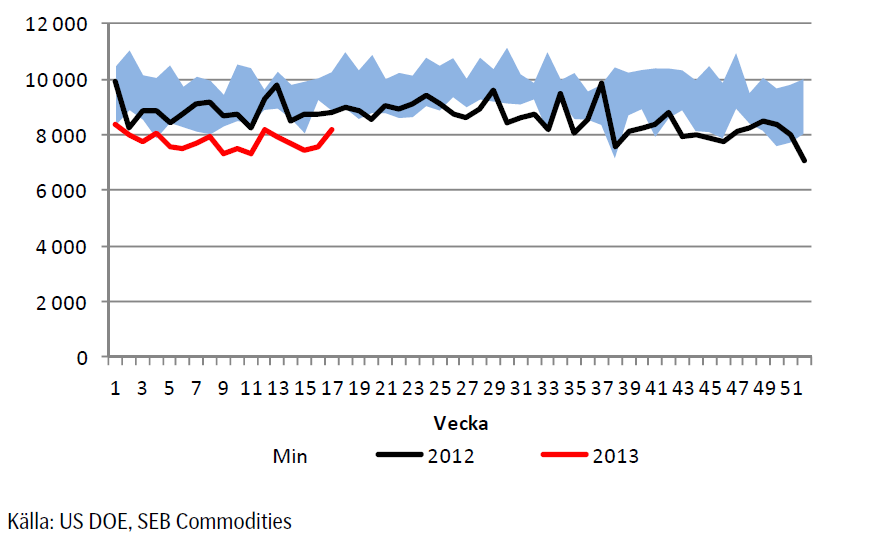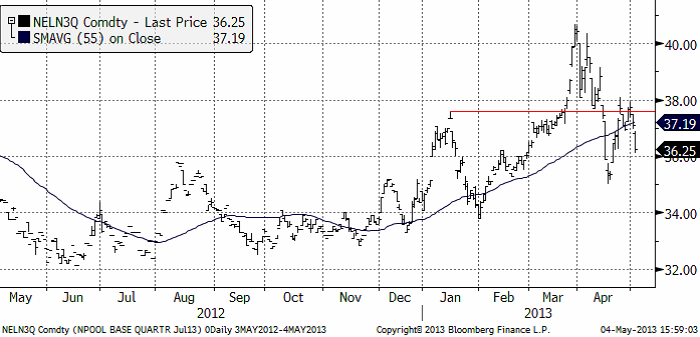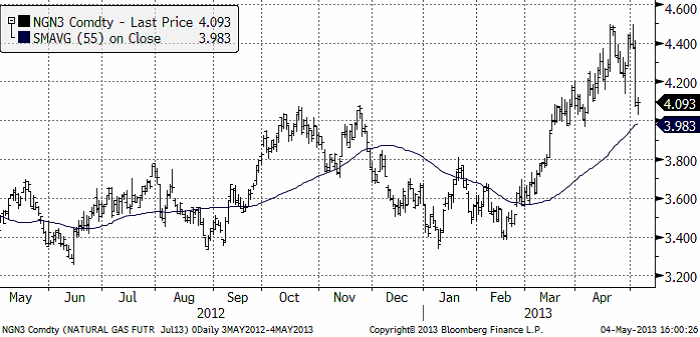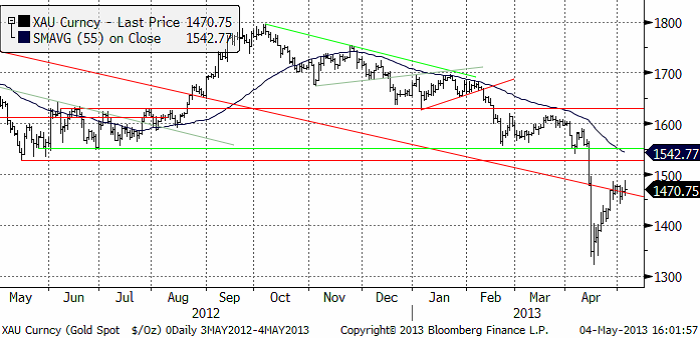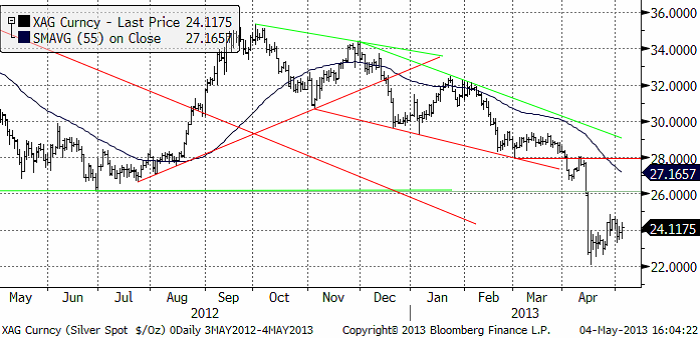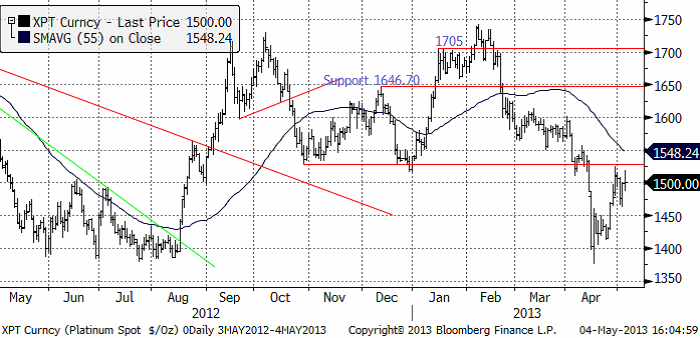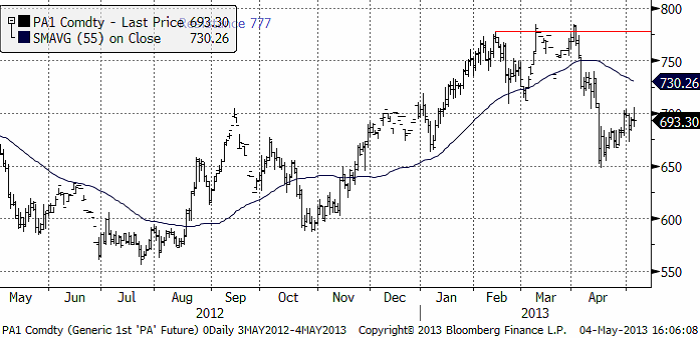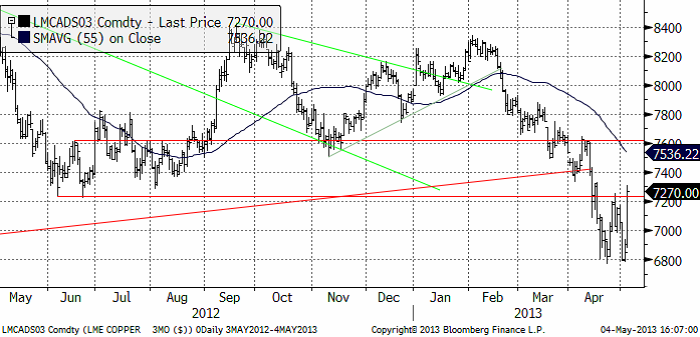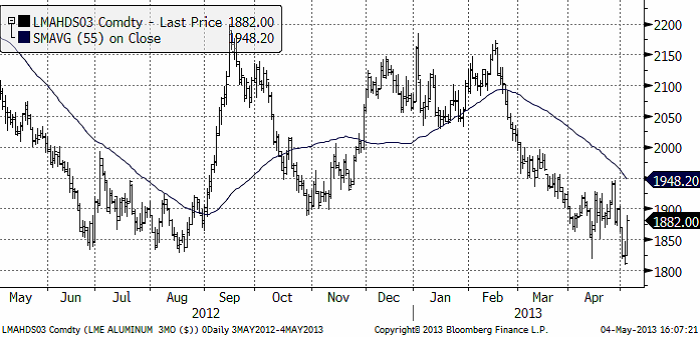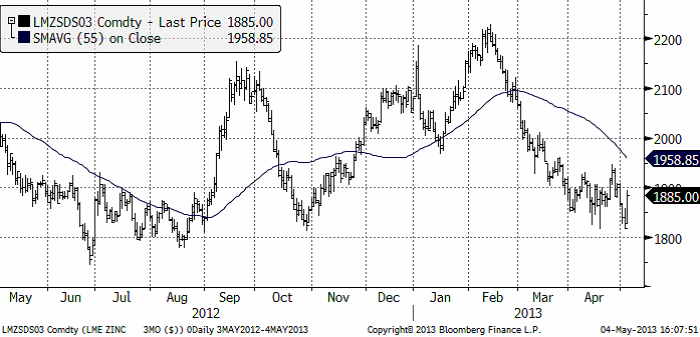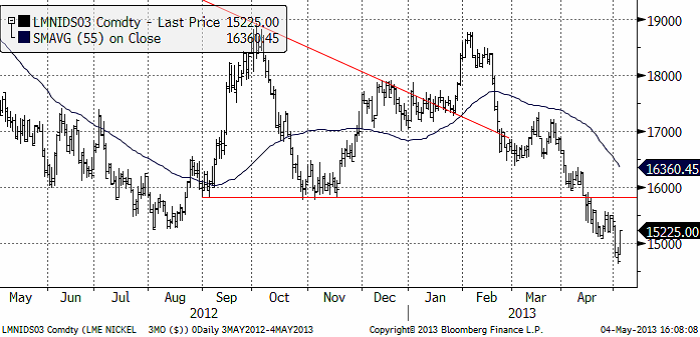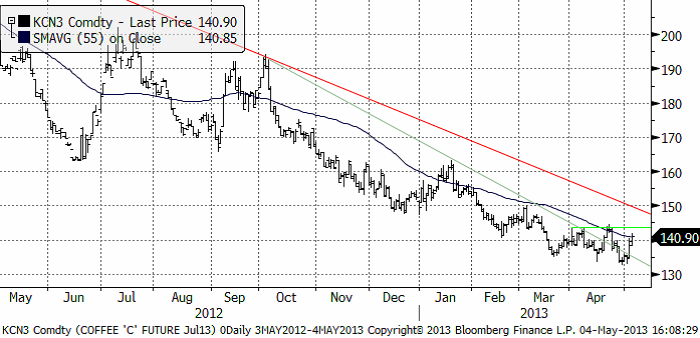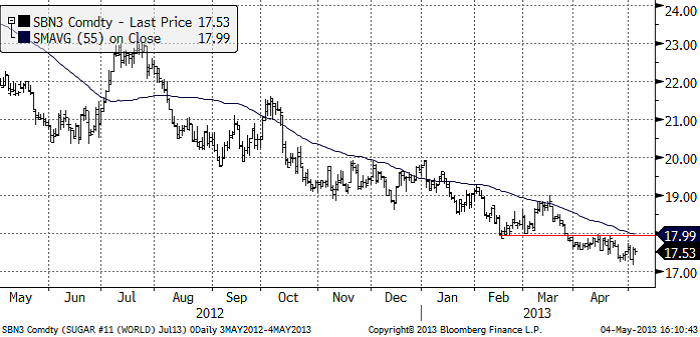Analys
SEB – Råvarukommentarer, 6 maj 2013
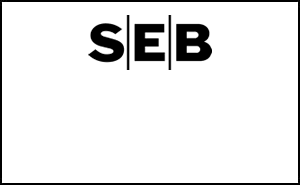
Rekommendationer
*) Avkastningen avser 1:1 råvarucertifikat där de ingår i rekommendationen. I den aktuella tabellen ovan har jag tagit prisförändringen den senaste veckan sedan det förra veckobrevet publicerades.
Inledning
Jag tror att guld, silver, platina och palladium, liksom olja står inför en korrektion nedåt i veckan som kommer. Om detta sker, kan dock priserna ha kommit ner så pass att det kan bli intressant att köpa dem på lite längre sikt.
Vete och majs har stabiliserat sig i pris på grund av det ovanligt kalla och blöta vädret i USA, som försenat sådden av majs så att den är rekordsen och fått höstvetet att vara i ännu sämre skick. Det har varit onormalt kallt överallt på jorden på ett sätt som avviker kraftigt från vad som var förväntat.
Råolja – Brent
Det var en volatil vecka för oljepriset. 100 dollar på nedsidan och 105 dollar på uppsidan. I fredags med positiv statistik från USA i ryggen försökte marknaden få upp oljepriset över 105 dollar, men det gick inte. Tekniskt ser det ut som om 105 dollar är en bra nivå att sälja på. Men det beror naturligtvis helt på om 105 bryts eller inte. Jag tror inte att marknaden orkar det.
Lagren och lagerförändringarna i USA den senaste rapportveckan ser vi nedan, enligt Department of Energy och American Petroleum Institute. Råoljelagren ökade kraftigt.
Nedan ser vi amerikanska råoljelager enligt DOE i tusen fat. Den svarta kurvan är 2012 års lagernivåer vecka för vecka och den lilla röda linjen är 2013 års nivå.
Importen har ökat och den trend av minskad import vi sett från mitten av förra året ser inte ut att fortsätta i år. De högre råoljelagren vi nämnde ovan, ser vi beror på att man importerade mer.
Vi fortsätter att ligga neutralt för att förhoppningsvis kunna komma in billigare i OLJA S om priset går ner till 100 dollar igen.
Elektricitet
Tekniskt har marknaden bytt mönster från ”bullish” till ”bearish”. Vi väljer därför att gå ur marknaden, i väntan på bekräftelse åt endera hållet.
Naturgas
Naturgaspriset fortsatte, som vi skrev förra veckan, upp mot 4.50 igen. Efter det föll priset abrupt. Det var olyckligt, men på den här nivån tror vi att naturgas är köpvärt igen.
Guld och Silver
Guldpriset har rekylerat färdigt, tror vi. Vi tror att man ska sälja guld nu, därför att vi tror att det kommer ett kursfall till. Det brukar alltid komma två kursfall med en rekyl emellan, när man haft en så kraftig teknisk säljsignal som vi fick i guld i början på april. När det kursfallet är klart tror jag man kan börja köpa guld igen.
Nedan ser vi kursdiagrammet för silver i dollar per troy ounce.
Vi ligger korta guld och silver. Det har kostat i veckan som gick, men eftersom vi tror att det kommer en till vända ner, ligger vi självklart kvar med köpt position i BEAR GULD X4 S och BEAR SILVER X4 S.
Platina & Palladium
Platinapriset har rekylerat uppåt, i likhet med guld och silver. Förra veckan rekommenderade vi att sälja långa positioner i platina. Den här veckan rekommenderar vi köp av BEAR PLATIN X4 S.
Prisfallet i palladium har stannat av och inte lyckats ta sig uppåt. Det ser ännu svagare ut än de andra. Vi rekommenderar köp av BEAR PALLAD X4 S. Målkursen är 600 dollar.
Basmetaller
Vi skrev i förra veckan att prissättningen av derivat indikerade en ökad volatilitet. Det fick vi se med besked under den gångna veckan. Delvis kan det ”skyllas” på tunna marknader p.g.a. ledigheterna kring 1:a maj. Kina hade stängt både måndag och tisdag, och stora delar av Europa under onsdagen (UK däremot öppet och därmed LME). Svagheten från fredagen följdes upp med säljtryck ända fram till torsdagen. Nyhetsmässigt var det främst rundan av inköpsindexsiffror som drev marknaderna. Både Kina och USA:s PMI backade mer än väntat, och ligger nu i båda fallen bara strax över 50-strecket. Marknaden har de senaste veckorna främst oroats för att återhämtningen i USA tappat fart. Effekten av fredagens överraskande positiva arbetsmarknadssiffra blev därför dramatisk. Priserna var redan mycket nedpressade. Fredagen bjöd på kraftiga uppgångar mellan 3 och 5 %. Sett över hela veckan ser det mindre dramatiskt ut, med marginella uppgångar. Undantaget är koppar som är upp 3,9 % på veckan.
Koppar
Som vi skrivit tidigare har vi haft kopparn under bevakning för att gå från neutral till köp. Tekniskt sett (se graf) stängde priset i fredags väldigt gynnsamt. Marknadens oro för USA lättade rejält efter fredagens arbetssiffra, som tyder på att ekonomin är på rätt spår. Många finansiella aktörer har dessutom positionerat sig för nedgång, vilket i sig kan skapa ett behov att köpa tillbaka korta positioner. Det är dock för tidigt att tala om en mer bestående vändning. Det behövs tecken på att Kina också är ”på spåret”. Säsongsmässigt är det nu som Kinas kopparimport ska ta fart, något som inte visats sig (ännu) i statistiken. Vi är positiva till basmetaller generellt, och vi har tidigare beskrivit vikten av att kopparmarknaden stabiliserades för att skapa förutsättningar för hela basmetallkomplexet. Veckans utveckling för koppar bådar därför gott för övriga metaller i veckan som kommer.
Vi förväntar oss fortsatt hög volatilitet. Vår kortsiktiga bedömning talar för uppsidan och vi rekommenderar därför köp av BULL KOPPAR X2 S eller X4 S.
Aluminium
Svagheten i mitten i veckan drabbade aluminium extra hårt och i vårt tycke ”oförtjänt” mycket. Priset fick dock tillfälle att testa nya låga nivåer under $1830, men det blev kortvarigt och köpintresset var massivt på de nivåerna. Vi ser intresse framför allt från industriella aktörer som ”täcker in” framtida konsumtion, men också från långsiktiga investerare som bedömer nivåerna som alltför låga för ett fortsatt ökat utbud. Högkostnadsproducenterna, framför allt i Kina, förväntas minska utbudet om priset långvarigt stannar på nuvarande nivåer. Kina annonserade redan i mars stängningar motsvarande ca 800 tton (att jämföra med ett förväntat globalt överskott på ca 1 milj ton). Fredagens positiva stängning (med hjälp av kopparns starka utveckling) ger grund för en följdrörelse uppåt i början av nästa vecka.
För den riskbenägne kan det vara läge för att köpa ett kontrakt med hävstång (BULL ALU X2 S eller X4 S). Långsiktigt är nivån väldigt intressant för kontraktet Aluminium S (utan hävstång).
Zink
Zinken följde i stort sett övriga metaller under veckan, och får en ganska neutral stängning på veckan. Produktionsstatistik från Kina är lite oroväckande för zinkens fundamentala balans. Smältverksproduktionen ökar i Kina, delvis som en effekt av stort gruvutbud (höjda smältlöner till smältverken). Risken finns att det behövs ännu lägre priser för att påverka gruvutbudet. Risken är att det dröjer innan priset vänder upp på allvar. Vi bedömer ändå zinken som fundamentalt ”billig” ur ett kostnadsperspektiv och nuvarande nivåer är mycket intressanta på lite längre sikt (6-12 månader). I det perspektivet är Zink S (utan hävstång) att föredra.
Nickel
Vi varnade i förra veckan för att det negativa stämningsläget kring nickel skulle kunna pressa marknaden under $15000. I den allmänna svagheten i mitten av veckan, gick det därför ganska lätt. Vi bedömde dock en sådan rörelse som kortvarig. Priset var som hastigast under torsdagen nere som lägst i $14625, vände väldigt snabbt och med hjälp av fredagens arbetsmarknadsstatistik får vi en positiv avslutning på veckan. Tekniskt sett balanserar marknaden på de kritiska nivåerna, och det är för tidigt att tala om en mer bestående vändning. Precis som för koppar är det finansiella kollektivet väldigt ”korta”, d.v.s. det finns ett stort behov att köpta tillbaka tidigare sålda terminskontrakt, som i sig för den volatila metallen nickel, kan skapa utrymme för en uppgång i veckan som kommer. Vi bedömer nivåerna som väldigt intressanta ur ett fundamentalt perspektiv. Högkostnadsproducenterna får problem om priset långvarigt ligger kvar vid nuvarande nivåer. Det har redan rapporterats om produktionsneddragningar i Australien, och det förväntas komma mer. Trots det bedöms marknaden vara i överskott, givet att inte efterfrågan från den rostfria industrin överraskar. Det kan således ta en tid innan vändningen för nickel kommer. Vi bedömer ändå nivåerna som väldigt attraktiva på 6-12 månaders sikt. I det perspektivet är Nickel S (utan hävstång) att föredra.
Kaffe
Kaffepriset (maj 2013) steg i veckan som gick. Förr eller senare kommer kaffepriset att vända uppåt. Den som söker en långsiktig placering i råvarumarknaden och har tålamod, kan säkert tjäna bra med pengar på certifikatet KAFFE S.
Socker
Sockerpriset (september 2013) fortsätter att ligga i fallande pristrend. Ingen skillnad från förra veckan. Socker och kaffe har följt varandra åt under lång tid, men medan kaffet visar lite tecken på trendvändning, ser man inte något alls av det i sockermarknaden. Vi fortsätter med neutral rekommendation.
[box]SEB Veckobrev Veckans råvarukommentar är producerat av SEB Merchant Banking och publiceras i samarbete och med tillstånd på Råvarumarknaden.se[/box]
Disclaimer
The information in this document has been compiled by SEB Merchant Banking, a division within Skandinaviska Enskilda Banken AB (publ) (“SEB”).
Opinions contained in this report represent the bank’s present opinion only and are subject to change without notice. All information contained in this report has been compiled in good faith from sources believed to be reliable. However, no representation or warranty, expressed or implied, is made with respect to the completeness or accuracy of its contents and the information is not to be relied upon as authoritative. Anyone considering taking actions based upon the content of this document is urged to base his or her investment decisions upon such investigations as he or she deems necessary. This document is being provided as information only, and no specific actions are being solicited as a result of it; to the extent permitted by law, no liability whatsoever is accepted for any direct or consequential loss arising from use of this document or its contents.
About SEB
SEB is a public company incorporated in Stockholm, Sweden, with limited liability. It is a participant at major Nordic and other European Regulated Markets and Multilateral Trading Facilities (as well as some non-European equivalent markets) for trading in financial instruments, such as markets operated by NASDAQ OMX, NYSE Euronext, London Stock Exchange, Deutsche Börse, Swiss Exchanges, Turquoise and Chi-X. SEB is authorized and regulated by Finansinspektionen in Sweden; it is authorized and subject to limited regulation by the Financial Services Authority for the conduct of designated investment business in the UK, and is subject to the provisions of relevant regulators in all other jurisdictions where SEB conducts operations. SEB Merchant Banking. All rights reserved.
Analys
More weakness and lower price levels ahead, but the world won’t drown in oil in 2026

Some rebound but not much. Brent crude rebounded 1.5% yesterday to $65.47/b. This morning it is inching 0.2% up to $65.6/b. The lowest close last week was on Thursday at $64.11/b.

The curve structure is almost as week as it was before the weekend. The rebound we now have gotten post the message from OPEC+ over the weekend is to a large degree a rebound along the curve rather than much strengthening at the front-end of the curve. That part of the curve structure is almost as weak as it was last Thursday.
We are still on a weakening path. The message from OPEC+ over the weekend was we are still on a weakening path with rising supply from the group. It is just not as rapidly weakening as was feared ahead of the weekend when a quota hike of 500 kb/d/mth for November was discussed.
The Brent curve is on its way to full contango with Brent dipping into the $50ies/b. Thus the ongoing weakening we have had in the crude curve since the start of the year, and especially since early June, will continue until the Brent crude oil forward curve is in full contango along with visibly rising US and OECD oil inventories. The front-month Brent contract will then flip down towards the $60/b-line and below into the $50ies/b.
At what point will OPEC+ turn to cuts? The big question then becomes: When will OPEC+ turn around to make some cuts? At what (price) point will they choose to stabilize the market? Because for sure they will. Higher oil inventories, some more shedding of drilling rigs in US shale and Brent into the 50ies somewhere is probably where the group will step in.
There is nothing we have seen from the group so far which indicates that they will close their eyes, let the world drown in oil and the oil price crash to $40/b or below.
The message from OPEC+ is also about balance and stability. The world won’t drown in oil in 2026. The message from the group as far as we manage to interpret it is twofold: 1) Taking back market share which requires a lower price for non-OPEC+ to back off a bit, and 2) Oil market stability and balance. It is not just about 1. Thus fretting about how we are all going to drown in oil in 2026 is totally off the mark by just focusing on point 1.
When to buy cal 2026? Before Christmas when Brent hits $55/b and before OPEC+ holds its last meeting of the year which is likely to be in early December.
Brent crude oil prices have rebounded a bit along the forward curve. Not much strengthening in the structure of the curve. The front-end backwardation is not much stronger today than on its weakest level so far this year which was on Thursday last week.

The front-end backwardation fell to its weakest level so far this year on Thursday last week. A slight pickup yesterday and today, but still very close to the weakest year to date. More oil from OPEC+ in the coming months and softer demand and rising inventories. We are heading for yet softer levels.

Analys
A sharp weakening at the core of the oil market: The Dubai curve

Down to the lowest since early May. Brent crude has fallen sharply the latest four days. It closed at USD 64.11/b yesterday which is the lowest since early May. It is staging a 1.3% rebound this morning along with gains in both equities and industrial metals with an added touch of support from a softer USD on top.

What stands out the most to us this week is the collapse in the Dubai one to three months time-spread.
Dubai is medium sour crude. OPEC+ is in general medium sour crude production. Asian refineries are predominantly designed to process medium sour crude. So Dubai is the real measure of the balance between OPEC+ holding back or not versus Asian oil demand for consumption and stock building.
A sharp weakening of the front-end of the Dubai curve. The front-end of the Dubai crude curve has been holding out very solidly throughout this summer while the front-end of the Brent and WTI curves have been steadily softening. But the strength in the Dubai curve in our view was carrying the crude oil market in general. A source of strength in the crude oil market. The core of the strength.
The now finally sharp decline of the front-end of the Dubai crude curve is thus a strong shift. Weakness in the Dubai crude marker is weakness in the core of the oil market. The core which has helped to hold the oil market elevated.
Facts supports the weakening. Add in facts of Iraq lifting production from Kurdistan through Turkey. Saudi Arabia lifting production to 10 mb/d in September (normal production level) and lifting exports as well as domestic demand for oil for power for air con is fading along with summer heat. Add also in counter seasonal rise in US crude and product stocks last week. US oil stocks usually decline by 1.3 mb/week this time of year. Last week they instead rose 6.4 mb/week (+7.2 mb if including SPR). Total US commercial oil stocks are now only 2.1 mb below the 2015-19 seasonal average. US oil stocks normally decline from now to Christmas. If they instead continue to rise, then it will be strongly counter seasonal rise and will create a very strong bearish pressure on oil prices.
Will OPEC+ lift its voluntary quotas by zero, 137 kb/d, 500 kb/d or 1.5 mb/d? On Sunday of course OPEC+ will decide on how much to unwind of the remaining 1.5 mb/d of voluntary quotas for November. Will it be 137 kb/d yet again as for October? Will it be 500 kb/d as was talked about earlier this week? Or will it be a full unwind in one go of 1.5 mb/d? We think most likely now it will be at least 500 kb/d and possibly a full unwind. We discussed this in a not earlier this week: ”500 kb/d of voluntary quotas in October. But a full unwind of 1.5 mb/d”
The strength in the front-end of the Dubai curve held out through summer while Brent and WTI curve structures weakened steadily. That core strength helped to keep flat crude oil prices elevated close to the 70-line. Now also the Dubai curve has given in.

Brent crude oil forward curves

Total US commercial stocks now close to normal. Counter seasonal rise last week. Rest of year?

Total US crude and product stocks on a steady trend higher.

Analys
OPEC+ will likely unwind 500 kb/d of voluntary quotas in October. But a full unwind of 1.5 mb/d in one go could be in the cards

Down to mid-60ies as Iraq lifts production while Saudi may be tired of voluntary cut frugality. The Brent December contract dropped 1.6% yesterday to USD 66.03/b. This morning it is down another 0.3% to USD 65.8/b. The drop in the price came on the back of the combined news that Iraq has resumed 190 kb/d of production in Kurdistan with exports through Turkey while OPEC+ delegates send signals that the group will unwind the remaining 1.65 mb/d (less the 137 kb/d in October) of voluntary cuts at a pace of 500 kb/d per month pace.

Signals of accelerated unwind and Iraqi increase may be connected. Russia, Kazakhstan and Iraq were main offenders versus the voluntary quotas they had agreed to follow. Russia had a production ’debt’ (cumulative overproduction versus quota) of close to 90 mb in March this year while Kazakhstan had a ’debt’ of about 60 mb and the same for Iraq. This apparently made Saudi Arabia angry this spring. Why should Saudi Arabia hold back if the other voluntary cutters were just freeriding? Thus the sudden rapid unwinding of voluntary cuts. That is at least one angle of explanations for the accelerated unwinding.
If the offenders with production debts then refrained from lifting production as the voluntary cuts were rapidly unwinded, then they could ’pay back’ their ’debts’ as they would under-produce versus the new and steadily higher quotas.
Forget about Kazakhstan. Its production was just too far above the quotas with no hope that the country would hold back production due to cross-ownership of oil assets by international oil companies. But Russia and Iraq should be able to do it.
Iraqi cumulative overproduction versus quotas could reach 85-90 mb in October. Iraq has however steadily continued to overproduce by 3-5 mb per month. In July its new and gradually higher quota came close to equal with a cumulative overproduction of only 0.6 mb that month. In August again however its production had an overshoot of 100 kb/d or 3.1 mb for the month. Its cumulative production debt had then risen to close to 80 mb. We don’t know for September yet. But looking at October we now know that its production will likely average close to 4.5 mb/d due to the revival of 190 kb/d of production in Kurdistan. Its quota however will only be 4.24 mb/d. Its overproduction in October will thus likely be around 250 kb/d above its quota with its production debt rising another 7-8 mb to a total of close to 90 mb.
Again, why should Saudi Arabia be frugal while Iraq is freeriding. Better to get rid of the voluntary quotas as quickly as possible and then start all over with clean sheets.
Unwinding the remaining 1.513 mb/d in one go in October? If OPEC+ unwinds the remaining 1.513 mb/d of voluntary cuts in one big go in October, then Iraq’s quota will be around 4.4 mb/d for October versus its likely production of close to 4.5 mb/d for the coming month..
OPEC+ should thus unwind the remaining 1.513 mb/d (1.65 – 0.137 mb/d) in one go for October in order for the quota of Iraq to be able to keep track with Iraq’s actual production increase.
October 5 will show how it plays out. But a quota unwind of at least 500 kb/d for Oct seems likely. An overall increase of at least 500 kb/d in the voluntary quota for October looks likely. But it could be the whole 1.513 mb/d in one go. If the increase in the quota is ’only’ 500 kb/d then Iraqi cumulative production will still rise by 5.7 mb to a total of 85 mb in October.
Iraqi production debt versus quotas will likely rise by 5.7 mb in October if OPEC+ only lifts the overall quota by 500 kb/d in October. Here assuming historical production debt did not rise in September. That Iraq lifts its production by 190 kb/d in October to 4.47 mb/d (August level + 190 kb/d) and that OPEC+ unwinds 500 kb/d of the remining quotas in October when they decide on this on 5 October.

-

 Nyheter4 veckor sedan
Nyheter4 veckor sedanMahvie Minerals i en guldtrend
-

 Analys4 veckor sedan
Analys4 veckor sedanVolatile but going nowhere. Brent crude circles USD 66 as market weighs surplus vs risk
-

 Nyheter4 veckor sedan
Nyheter4 veckor sedanAktier i guldbolag laggar priset på guld
-

 Nyheter3 veckor sedan
Nyheter3 veckor sedanKinas elproduktion slog nytt rekord i augusti, vilket även kolkraft gjorde
-

 Nyheter3 veckor sedan
Nyheter3 veckor sedanTyskland har så höga elpriser att företag inte har råd att använda elektricitet
-

 Nyheter4 veckor sedan
Nyheter4 veckor sedanGuld når sin högsta nivå någonsin, nu även justerat för inflation
-

 Nyheter4 veckor sedan
Nyheter4 veckor sedanDet stigande guldpriset en utmaning för smyckesköpare
-

 Analys4 veckor sedan
Analys4 veckor sedanWaiting for the surplus while we worry about Israel and Qatar


